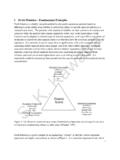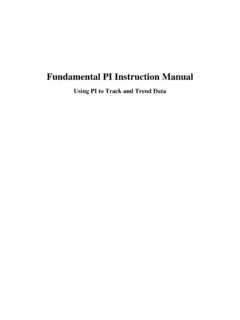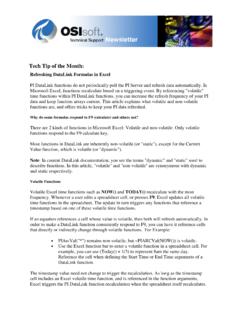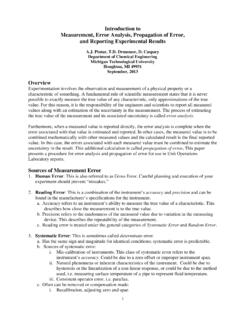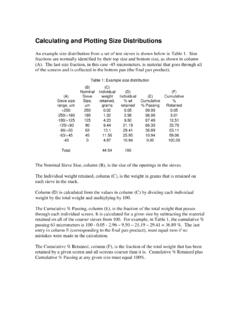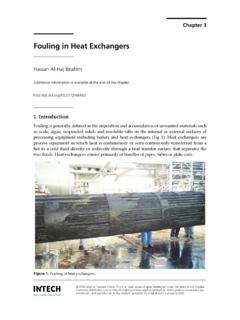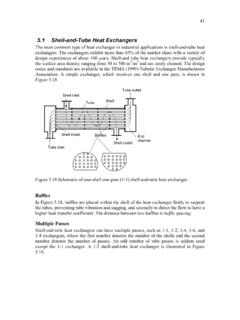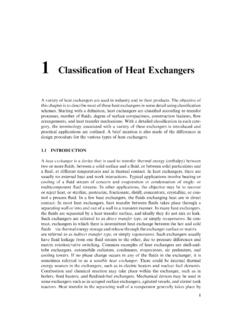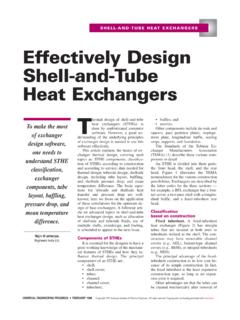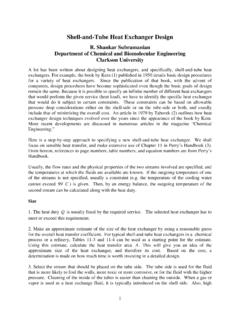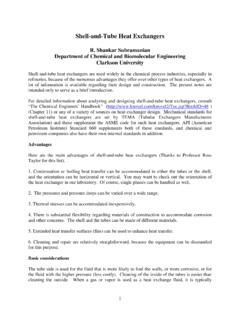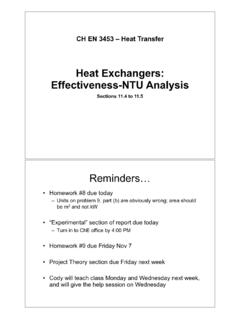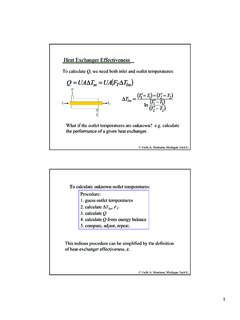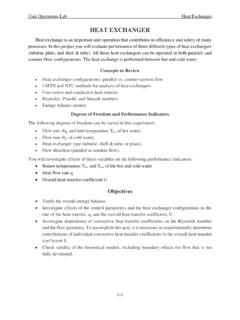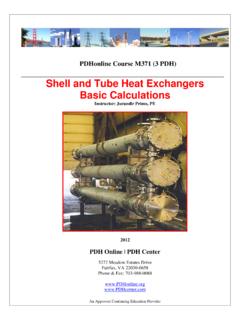Transcription of Shell and Tube Heat Exchanger - Department of Chemical ...
1 Shell and Tube heat ExchangerOctober 7, 20 XXCycle 2 Group 1 XMeYouHerHimUse subtle, pleasing background. This one is a bit too ominous like the Hand of God is about to reach out and touch Objectives Background Experimental Strategy Results Error Analysis Conclusions Recommendations ReferencesSelect a font size that is appropriate for the size of the room and size of the projection screenNumber your slides this is required and helps the audience during Q&A outline slide is and BackgroundYou only have 10 minutes. Create transitions but know that separate transition slides can waste time. Each slide has to be visible long enough for the audience to absorb the Operate Shell and tube heat Exchanger varying steam flow Determine the outside overall heat transfer coefficient (Uo) Determine shellside heat transfer (QSS) Determine tubeside heat transfer (QTS)Condense the objective into the primary objective(s).
2 Do not list all tasks Exchanger Background Exchange heat between fluids Latent heat and sensible heat transfer Common to Chemical process industry Types of heat exchangers Air Cooled Double Pipe Spiral Plate and Tube Shell and TubeNeed to provide context (Background) for your work, but maintain focus on Objective(s) --> Results --> Conclusion(s) --> Recommendation(s) heat Exchanger BackgroundShell and Tube heat Exchangers Account for 60% of heat exchangers in use today Can handle large flows, low temperatures and pressures, high temperatures and pressures Our Shell and tube heat Exchanger Basco Type 500 U-tube Water Heater 1 Shell Pass 16 TubesExperimental StrategyEquipment Diagram is required.
3 Do not use instrument labels, use descriptive it Strategy 5 Runs Total Varied Steam Valve (TV-04) Position 105% open 75% open 65% open 60% open 52% open Cooling water flow rate constant 5 Runs ??One test at each of 5 conditions, or 5 replicates at each of these 5 test conditions?What does 105% open mean to the audience?These two experimental strategy slides say what was done, but not why this method was Strategy Measured Variables Condensate flow Condensate temperature Cooling water flow Cooling water inlet temperature Cooling water outlet temperatureCan this be condensed?Can a picture help to eliminate most of this text? heat Exchanger Calculations heat transfer rate QTS= mCp T QSS= m H + mCp T Overall heat transfer coefficient Uo= QSS/(Ao* TLM) Log mean temperature TLM = ((Thi-Tco) (Tho Tci)) / ln[(Thi Tco) (Tho Tci)]The equations used must be shown in a needs to be Process Flow DiagramThiThoTciTcoQout, TSQin, TSQin, SSQout, SSThis picture could have been used to show what/ where measurements were ResultsSteam Valve% OpenHeat Transfer Rate (QTS)(btu/hr) heat Transfer Rate (QSS)(btu/hr)Overall heat Transfer Coefficient (Uo)(btu/lb*F*hr)
4 105%27648927535021175%25027525458820165% 18335718187214860%13420013377711252%9828 99375778 Compare these tabulated results to the graphs in the next is easier for the audience to absorb?Pay attention to significant figures!Shellside vs. Tubeside heat TransferHe at T r an f e r Rat e ( Q)Q-tube s ide vs . Q-s he lls ide9000014000019000024000029000075000125 000175000225000275000 Qshellside(btu/hr)Qtubeside(btu/hr)Both values are equal. So, both axes should be scaled Mass Out (lb/hr)Hate Transfer Rate (btu/hr)Q-ShellsideQ-TubesideSteam vs. heat Transfer Rate (QTS, QSS)Maybe after too many hours analyzing the vs. Overall heat Transfer Coefficient50100150200250300501001502002 50300 Condensate Mass Out (lb/hr) heat Transfer Coefficient (btu/lb*F*hr)
5 U insideU outsideError AnalysisPropagation of Error Determine the accuracy of measured variables Apply the propagation of error equation to each function2112 kiiixxyyThe only thing important here is that RMS error propagation method was Measurement Accuracy Flow rate of the steam +/- 5 lb/hr Flow rate of the cooling water +/- 50 lb/hr Temperature readings +/- 2 F Largest sources of error Mass flow rate of the steam Mass flow rate of the cooling waterThese values can be reported with the tabulate key results with uncertainty, or show graphically with error Error Values QTS +/- 1,000 btu/hr QSS +/- 50,000 btu/hr Uo +/- 4 btu/lb F hr Ui +/- 4 to +/- btu/lb F hrThe problem with Error Analysis is that it is a lot of work, and you want everyone to know how hard you worked on all these slides (and any other supporting slides) after the Q&A slide at the anyone has follow up questions on this, you can take them to the extra slides.
6 This is an excellent technique that can really impress your of Error heat Transfer90000140000190000240000290000340 00075125175225275 Condensate Mass Out (lb/hr) heat Transfer Rate(btu/hr)Q-tubesideQ-shellsideThis is just a repeat of an earlier slide with error bars included. Why put the audience through it twice?Propagation of Error heat Transfer Coefficient50100150200250300501001502002 50300 Condensate Mass Out (lb/hr) heat Transfer Coefficient (btu/lb*F*hr)U insideU outsideConclusions and QTS, QSS, Uoall increase as the steam flow rate increases QTS, QSS, Uoall have a linear relationship with the mass flow rate of the steam heat transfer rate of the tube side is equal to the heat transfer rate of the Shell sideRecommendations Operation Recommendation Operate the Shell and tube heat Exchanger at approximately 75% for sufficient heat transfer and economic efficiency Experiment Recommendations Monitor pressure gauge (PG-07)
7 At low steam rates to prevent a vacuumThe first one is one has nothing to do with anything else presented up to this API heat Transfer. Shell and Tube heat Exchanger Georgia Tech. Propagation of Error. August 2002. Geankoplis, Christie J. Transport Processes and Unit Operations, 3rd ed. Englewood Cliffs, NJ. Prentice-Hall Publishing, Inc. 1993. Heald, C. C. Cameron Hydraulic Data. Liberty Corner, NJ. Ingersoll-Dresser Pump Co. 1998. Peters, Timmerhaus, West. Plant Design and Economics for Chemical Engineers, 5th ed. New York, NY. McGaw-Hill Co. Inc., required presentation was 28 slides. That s enough for most 50 minute lectures!
8 You only have spelin errors?Appropriate grammar?Format consistency?Punctuation consistency? a t rush on voice rate, volume, casual language!Show confidence you just ran the experiment and calculated the results you are the resident expert on this project!
